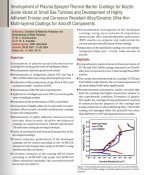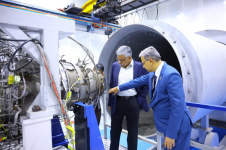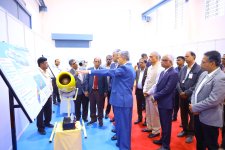You are using an out of date browser. It may not display this or other websites correctly.
You should upgrade or use an alternative browser.
You should upgrade or use an alternative browser.
Now this is something.
Any relation to the engine for IMRH?
Help from reddit for the document
Any relation to the engine for IMRH?
Help from reddit for the document

Attachments
From the same event:

Wide chord fan blades for the intake fan.
BLISKs for the 1st & 2nd stage compressors.
3D printed guide vanes.
HAL's design manufacturing capacity for engines has gone up a few notches in the last few years. All of these were developed for the HTFE/HTSE projects. Neither Kaveri nor any of the Russian engines that HAL produces under license has any of these.

Wide chord fan blades for the intake fan.
BLISKs for the 1st & 2nd stage compressors.
3D printed guide vanes.
HAL's design manufacturing capacity for engines has gone up a few notches in the last few years. All of these were developed for the HTFE/HTSE projects. Neither Kaveri nor any of the Russian engines that HAL produces under license has any of these.
AERDC & GTRE working seperately on engine programs is another major factor on why we lag.HAL’s Aero Engine Research and Development Centre (AERDC) in Bengaluru was inaugurated today.
HTFE-25 engine on a test bench:
View attachment 31483
PTAE-7 turbojet engine:
View attachment 31485
you mean if two bricks which sink separately when joined together will be able to float. Thats either quantum physics or blind belief, not able to make out which one it is.AERDC & GTRE working seperately on engine programs is another major factor on why we lag.
Kaveri was developed by GTRE while all the ToT (be it of any level) for AL31FP, RD33 se-3, Adour lies with HAL.you mean if two bricks which sink separately when joined together will be able to float. Thats either quantum physics or blind belief, not able to make out which one it is.
Why not make use of all the resources together.
Similarly GTRE has required experience of testing a new system, their facilities & manpower will be crucial to HALs engine efforts.
One of the reason engine program has not achieved expected success due to our expertise in metallurgy, simply put technical ability. If solution was in organizational restructuring then this would have taken place long time back. As you have rightly mentioned this restructuring will result in cost & operational efficiency but from perspective of technical output dont expect any thing to change.Kaveri was developed by GTRE while all the ToT (be it of any level) for AL31FP, RD33 se-3, Adour lies with HAL.
Why not make use of all the resources together.
Similarly GTRE has required experience of testing a new system, their facilities & manpower will be crucial to HALs engine efforts.
Maybe.One of the reason engine program has not achieved expected success due to our expertise in metallurgy, simply put technical ability. If solution was in organizational restructuring then this would have taken place long time back. As you have rightly mentioned this restructuring will result in cost & operational efficiency but from perspective of technical output dont expect any thing to change.
But dividing already scarce recourses into two will not help. Why spend fixed costs twice ? Why do the process twice?
Maybe.
But dividing already scarce recourses into two will not help. Why spend fixed costs twice ? Why do the process twice?
Why not? HAL is focusing on engines for the products they produce, which are usually smaller. It is primarily a production house, not a design one.
While GTRE is a dedicated R&D lab for nationally important higher end engines.
For HAL, engine development is an afterthought. HTFE or HTSE will not enter production this decade because it is not a priority. HAL is corporate entity that needs to generate revenue for its stakeholders but GTRE does not.
There isn't much fixed cost duplication as you think. These are smaller testing infrastructures.
You could make the same argument about ADA and HAL, which does not hold water.

Powering Proliferation: The Global Engine Market and China’s Indigenization
The military turbofan engine market proliferates technology nations like China need to build modern jet engines to compete with the United States. This brief explores China’s push to modernize its capabilities and broader dynamics in the global military engine market.
Combat air power is one of the cornerstones of modern military might—and it relies on dependable, advanced propulsion systems. Jet engines require sophisticated design and manufacturing expertise, which has been built up in aircraft engine–producing nations over decades. The engine is the heart of the combat air power and integrated weapon systems. Jet engines not only produce thrust, but also power avionics and aircraft systems. This paper examines major non-U.S. players in the engine market, with a particular focus on both allies and potential adversaries. It also analyzes how China has sought to translate its growing technological prowess into a military engine industrial base. Beginning with British sales of engine technology to China in the 1970s and supported by Russian assistance after the fall of the Soviet Union, Beijing has been making a long-term concerted effort to develop an organic, fully indigenous, manufacturing capacity—albeit with mixed success. Evidence suggests China will continue to focus on developing this capacity, raising questions about both its military capabilities and how the turbofan market may evolve with the entrant of a new competitor.
One barrier to Chinese domestic engine manufacturing is the availability of machine tooling that is suitable for aerospace applications. While the engines can be made of components completely produced in China, they are manufactured on Western machines. The most complex machine tools, five-axis and seven-axis systems, require immense engineering talent to manufacture and operate, and Chinese aerospace firms still have to import these systems from abroad[50]—including from German, Japanese, Italian, and likely Korean firms.
Another barrier to large-scale Chinese jet engine manufacturing is lack of knowledge of how to optimize the manufacturing process, despite attempts to exfiltrate this information. In 2018, Chinese-American citizen Xiaoqing Zheng was convicted by the U.S. Department of Justice (DOJ) for his involvement in stealing trade secrets regarding turbine sealing, a dual-use technology that is commonly employed in the development of aero engines.[55] In another case, Chinese intelligence officer Xu Yanjun targeted experts employed by Western aerospace companies to both provide sensitive manufacturing data and speak to Chinese engineers in an effort to improve the country’s manufacturing processes.[56] However, China has not yet been able to use the stolen information successfully to indigenize its aircraft engine industry.
Historically, Chinese engines have been lagging their Western counterparts by roughly 30 years.[58] In recent years, China’s efforts to develop maritime turbines, which rely on less complex but similar technology, seem to have taken closer to 15 years.












